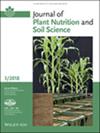Changes in the soil microbial community 5 years after the application of sewage sludge biochar to soils cultivated with corn
Abstract
Background
Sewage sludge biochar has been widely used in agriculture for various purposes; however, knowledge about its residual effect on the soil microbial community is limited.
Aims
This study aimed to evaluate changes in the microbial community 5 years after the application of sewage sludge biochar.
Methods
Biochar was produced from sewage sludge obtained at a wastewater treatment pyrolyzed at 300°C (Biochar300) and 500°C (Biochar500). Both biochar treatments were applied in corn fields for two growing seasons (2014/2015; 2015/2016). Biochar was not applied from the third (2016/2017) to the seventh (2020/2021) growing season to assess the residual effect. Soil samples were collected after harvesting in 2020/2021 growing season, therefore in the fifth year subject to the residual effects of biochar. The microbial community was evaluated by accessing bacterial and fungal groups using DNA techniques. Amplicon sequencing analysis was performed with the samples by Illumina MiSeq 250 bp.
Results
At genus level, the Lachnospira, Faecalibacterium, Bacteroides, Epulopiscium, and Parabacteroides were affected by Biochar500. Furthermore, at upper levels of taxonomy, this biochar treatment increased the relative abundance of bacterial classes Clostridiaceae and Bacteroidia and the fungal families Chaetomiaceae and Aspergillaceae. Concerning the relationship between microbial community and soil chemical properties, soil phosphorus (P) and calcium (Ca) were significantly affected by biochar treatments within the bacterial community; the fungal ones affected significantly soil P and potential acidity (H + Al).
Conclusions
Even under the residual effect of 5 years, the application of biochar altered the microbial community on corn plantation, especially concerning on the richness and the abundance of some groups. Biochar500 was the most responsive among the treatments.

 求助内容:
求助内容: 应助结果提醒方式:
应助结果提醒方式:


